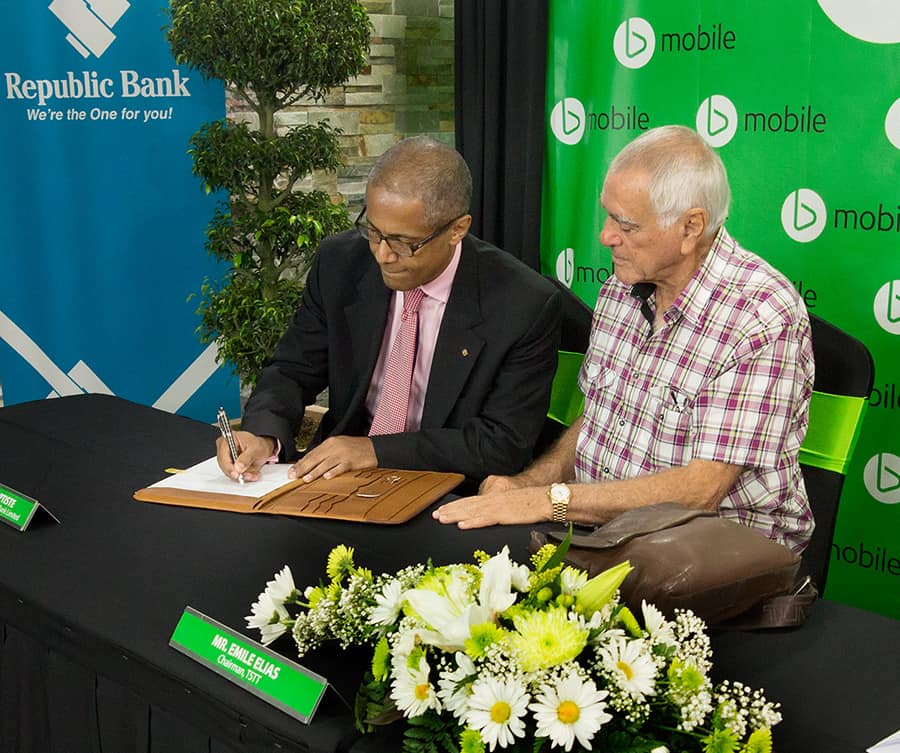
Above: Republic Bank’s Managing Director Nigel Baptiste and TSTT Chairman Emile Elias sign a $1.95 billion agreement for infrastructure development at the telecommunications company. Photo by Mark Lyndersay.
BitDepth#1070 for December 06, 2016
“We have begun our transformation,” declared TSTT CEO Dr Ronald Walcott at Friday’s press conference to announce new branding and a financial partnership with Republic Bank to the tune of $1.95 billion.
Later that night, with surprising swagger before an audience that generally and tragically ignored his short speech – the price of admission for the telecommunications company’s annual media Christmas party – Dr Walcott would amplify those sentiments.
“I am declaring here,” he told the small knot of people around him paying attention to his talk, “that we rule this space, and anyone else in the business should take heed.”
TSTT has killed off the ill-advised Blink brand (Did they realise what on the blink means?)in favour of its much better known bmobile identity for customer services.
The telecommunications company will operate as a corporate entity known as TSTT, but all its customer facing services will now be branded with a new, flat design “b” logo which takes its inspiration from the graphic for the Bing search service but is a paper clip all its own.
At the morning media press conference, a silent, dark suited squad from Republic Bank accompanied the financial institution’s Managing Director, Nigel Baptiste, but Mr Baptiste notably did not join the panel addressing the media contingent nor did he speak at the formal event, signing the paperwork with a professional smile and accepting a glass ornamental memento of the financial deal.
TSTT’s board has approved a $3.7 billion infrastructure and services improvement plan that is designed to make the company more competitive.
“TSTT and CAL are the two state agencies that operate public services that face international competition without any barriers of protection,” said TSTT chairman Emile Elias.
Elias noted that he had already told TATT to get a bush bath (he warns TATT about gru-gru bef thorns here) when the telecommunications oversight agency did not renew TSTT’s license.
“I can’t tell you what I did, but we did get the license.”
The TSTT chairman wasn’t done with his signature straight talk either.
“If I find that state agencies are giving business to someone else and not to us, there will be consequences. Because you are breaching the manual of public sector governance.”
Dr Walcott noted that the company had spent $900 million as capital expenditure on the project to date out of current cash flow. The balance of the budget for infrastructure improvement will come out of future cash flow over the five-year programme’s life.
TSTT is also quite cheerful about announcements it has scheduled for later this week. It is expected to announce favourable half-year financial results and an overdue revamp of its mobile package offerings, which it has been hinting quite broadly at for months.
The telecommunications company has made the four pillars of its improvement programme public since July. It will evolve and upgrade its technology, pursue greater than 20 per cent revenue growth, transform its customer service and realign its business processes.
Dr Walcott should be warned that the past is prologue.
TSTT’s history of technology implementation over the last ten years hasn’t been inspiring. The company stuck with Edge data technology too long and allowed rival Digicel to take a nine-month lead on them in the introduction of 4G technology. It probably didn’t help that virtually the entire board at the time was technology illiterate.
The company did a costly upgrade to WiMax just as the technology was becoming obsolete and when it finally implemented 4G, it was a version that sat on the borderline of 3G dataspeeds.
CTIO Roger Richards offered a pained smile at my recounting of these damaging missteps, but argued that the company’s current plans will replace aging GSM technology with modern UMTS (Universal Mobile Telecommunications System) based hardware, modernising existing systems to compliance with the newer protocol. The company has already begun offering handsome trade-ins for older phones that are incompatible with UMTS.
“Wherever it is too old, we are doing blank slate installations with the intention of implementing an LTE wireless broadband product that is a market leader in the Caribbean,” Richards said, “one with parity with anything available in the first world.
“These are not snap-your-finger solutions, but we are committed to customers in T&T feeling the impact of our investments as soon as possible.”
The company has already implemented HD voice technology on its network.
Dr Walcott acknowledged the pecularities of TSTT’s staff profile, which is overstaffed in support of ageing systems and technologies and undermanned in innovation and new implementation projects
.“As with the legacy systems, there is a skills gap,” he said.
“We are dealing with it through discussions with the union, retraining and restructuring and I would describe that process as 50 percent complete.”
TSTT is following the Muhammad Ali playbook closely. Training hard for a year, talking big and bold on the verge of entering the ring again and by the end of this week, when TSTT fully throws off its robes, it will be much clearer which fight we’re going to see, the Fight of the Century (which Ali lost after taking a terrible beating from Joe Frazier) or the Rumble in the Jungle (which Ali won after being battered fiercely by George Foreman).


